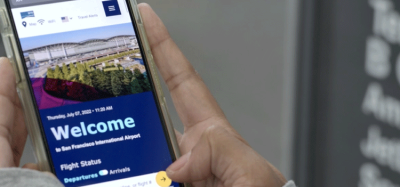Digital identities and airport responses to COVID-19
- Like
- Digg
- Del
- Tumblr
- VKontakte
- Buffer
- Love This
- Odnoklassniki
- Meneame
- Blogger
- Amazon
- Yahoo Mail
- Gmail
- AOL
- Newsvine
- HackerNews
- Evernote
- MySpace
- Mail.ru
- Viadeo
- Line
- Comments
- Yummly
- SMS
- Viber
- Telegram
- Subscribe
- Skype
- Facebook Messenger
- Kakao
- LiveJournal
- Yammer
- Edgar
- Fintel
- Mix
- Instapaper
- Copy Link
Posted: 26 August 2021 | Jean-Sébastien Pard, Kirk Goodlet | No comments yet
Kirk Goodlet, Director – Airports at the Winnipeg Airport Services Corporation, and Jean-Sébastien Pard, Director of Facilitation and Passenger Services at ACI World, discuss how passenger digital identities supported airports’ responses to COVID-19.


The use of biometrics to support airport and airline processes is not new. On the contrary, ePassports have been around for more than two decades, and using fingerprints or irises for security purposes has been a reality for just as long. In the latter 2010s, airports sought new ways to facilitate the movement of passengers in light of serious capacity-related challenges. Check-in lobbies and security checkpoints, for example, reached capacity in some of the global mega hubs, which forced airport operators to take a hard look at their processes and the ways in which congestion affected passenger experience.
Since the beginning of the pandemic, a collective of airport members and World Business Partners involved in the Airports Council International (ACI) World Facilitation and Services Standing Committee – Aeropuerto de Carrasco (MVD), Bangalore International Airport (BLR), Corporación América Uruguay, Idemia, InterVISTAS Consulting, Pangiam and Winnipeg Airport Services Corporation – have been working on the Future of Travel and Digital Identity Report. Recently issued, this new report focuses on various digital identity initiatives across the world and how these initiatives may influence airports in the future.
The use of biometrics to support airport and airline processes is not new. On the contrary, ePassports have been around for more than two decades, and using fingerprints or irises for security purposes has been a reality for just as long. In the latter 2010s, airports sought new ways to facilitate the movement of passengers in light of serious capacity-related challenges. Check-in lobbies and security checkpoints, for example, reached capacity in some of the global mega hubs, which forced airport operators to take a hard look at their processes and the ways in which congestion affected passenger experience.
Since the beginning of the pandemic, a collective of airport members and World Business Partners involved in the Airports Council International (ACI) World Facilitation and Services Standing Committee – Aeropuerto de Carrasco (MVD), Bangalore International Airport (BLR), Corporación América Uruguay, Idemia, InterVISTAS Consulting, Pangiam and Winnipeg Airport Services Corporation – have been working on the Future of Travel and Digital Identity Report. Recently issued, this new report focuses on various digital identity initiatives across the world and how these initiatives may influence airports in the future.
The evolution of digital identities
Initiatives to facilitate the movement of passengers efficiently and safely were well underway before the COVID-19 pandemic hit the aviation industry circa March 2020. While these initiatives were first envisaged to solve challenges around efficiency, digital identity initiatives quickly pivoted to solve a host of complications associated with COVID-19 and its profound effects on the aviation sector.
As a response to the global health crisis, digital identity initiatives began to focus less on capacity and more on consistency in how information, especially entry or exit requirements, is transmitted across stakeholders. As COVID-19 testing results and, more recently, vaccines are being introduced across the globe, there is an increasing need to standardise and harmonise documentation in a way that is recognised by states, airlines and airports.
As President and CEO of InterVISTAS Consulting Inc., Solomon Wong said: “There are many opportunities to accelerate seamless travel globally: from origin, flights, connections and other modes of transportation – all while making it as easy as possible for passengers and stakeholders through pandemic recovery. Airports play a critical role in helping governments, airlines, travel retail and other parties to create interoperable solutions, as well as going above and beyond for digital trust and privacy.”
For decades prior to COVID-19, “the traveller has been subjected to complex validations for multiple travel and identity documents at various touchpoints throughout the airport. Today, more than ever, there is a need to simplify these processes and tag all of the necessary checks and validation to the single token of face biometrics, thus enabling a seamless, hassle-free, contact‑free and health-risk-free journey. Enabling a globally interoperable ecosystem and data sharing standards and platforms is the need of the hour,” said Suresh Khadakbhavi, Assistant Vice President of the Innovation Lab of Bangalore International Airport.
For the industry to support recovery, a passenger must feel confident in the process. For example, if a passenger needs to travel from Winnipeg, Canada to Guangzhou, China with a couple of transit points in between, the documentation requirements alone are enough to dissuade them from travelling altogether. This scenario must be prevented in an effort to win back the confidence of consumers and support our once vibrant industry.
The role of digital identities in the industry recovery
For that reason, initiatives like The Commons Project’s ‘Common Pass’ or the International Air Transport Association’s (IATA) ‘IATA Travel Pass’ strive to collate an individual’s health records in a secure and standardised way. The Good Health Pass Collaborative – a cross-sector initiative bringing together leading organisations to create a blueprint for interoperable digital health pass systems – is another scheme in which ACI has contributed since its beginnings. These examples highlight some of the ways in which digital identity initiatives have pivoted in response to COVID-19.
Federico Cabrera, Airport Operations and Customer Experience Manager at Aeropuerto de Carrasco in Montevideo, said: “Digitalising airport processes increases security and passenger experience, and there are numbers of initiatives worldwide exploring this path. This report is essential, because it helped to bring to the forefront the importance of using global standards for information and data sharing.”
While the industry generally agrees in the principles of interoperability, standardisation and harmonisation, there remains a high degree of fragmentation in how digital identities and data are created, shared and stored across biometric initiatives. Each trial might propose different means by which a digital identity is created or distributed between airports, airlines and government agencies. In part, this is due to an absence in a standard approach to digital identities, which has led to several competing and overlapping initiatives. “Digitalisation of processes, along with an enhanced identity management powered by biometrics, were already requested by passengers before the COVID-19 crisis. They were considered as strong levers to enhance the passenger experience by proposing a more streamlined journey. Even though the pandemic changed our paradigm, those levers will continue to reshape travel, as they are needed more than ever to support the relaunch of the industry,” said Pedro Alves, Vice President of Global Business Development – Extended Borders for Idemia.
While the industry generally agrees in the principles of interoperability, standardisation and harmonisation, there remains a high degree of fragmentation in how digital identities and data are created, shared and stored across biometric initiatives”
In October 2020, the International Civil Aviation Organization (ICAO) introduced a timely and fundamental document to support digital identities in the future. In its document, ‘Guiding Core Principles for the Development of Digital Travel Credential (DTC)’, ICAO explains the DTC concept and defines the DTC lifecycle, from creation to revocation. While there are several ways to facilitate data from one stakeholder to another, ICAO has laid out a profoundly important foundation on which digital identities can build. As a result, existing initiatives will need to reconcile how the DTC plays into each.
ICAO has played a pivotal role during this pandemic, and their role in standardisation of e-Machine Readable Documents (e-MRD) both before, and during, the pandemic cannot be overstated. The ACI World digital identity report makes clear that the DTC concept should be prioritised as the primary form of digital identity. Nevertheless, additional trials – and those currently underway – must highlight best practices on how data are facilitated across the travel continuum.
Pedro Alves said: “The convergence of Digital ID in the travel process is accelerating and enabling new aspirations for an enhanced, more secure and an even more passenger-centric experience. With a trusted source of identity and the multiple options for Digital ID, namely the advent of DTC (Digital Travel Credential) and IMP (Identity Management Platform), combined with biometrics and health information, the passenger can finally aspire to be in control of his/her journey, in addition to enjoying a fully contactless journey which has emerged during the crisis as one main aspiration from passengers.”
Digital innovation in a time of crisis
Given the profound impact that COVID-19 has had on the aviation sector, it is difficult to celebrate much in the last year. Yet, the global response to COVID-19 has expedited work on digital initiatives and, in some ways, accelerated collaboration between airports, airlines and governments. For Simon Wilcox, Vice President at Pangiam, digitisation of the passenger journey has never been so critical, and the ‘Digital ID’ is just one key element: “For years we have looked to automate and digitise parts of the air travel industry, and the pandemic has driven the adoption of new technology and has shown us the need to create a more integrated experience. Collaboration and data sharing is the ‘new normal’ and, if done in a standardised way, it will offer an improved passenger experience and aid recovery.”
The DTC and the ways in which digital identities are established will enhance initiatives to create a health ‘passport’ or certificates. These same responses to COVID-19 might also accelerate the standardisation and digitisation of visas or other travel authorisations. In any case, the pandemic has reminded us that our industry is as fragile as it is vibrant. It has reinforced the need to collaborate broadly and effectively. The spread of COVID-19 has forced stakeholders to pivot on trials and to consider adding new layers of biosecurity to established initiatives. The degree to which the air industry and governments are aligned has never been closer. “The stronger and closer collaboration between all stakeholders (including government for border control application) is already a reality and is expected to gain more ground in the future,” said Pedro Alves. He added: “This will even further stress the need to rely on a digitalised process where information can be trusted and easily shared among all actors.”
“The fourth revolution is transforming the world in all aspects,” said Ricardo Cerri, Chief Technology Officer at Corporación América Uruguay. “I personally see this profound crisis re-shaping our industry in such a way that it is currently demolishing barriers which prevented us from applying many of the available technologies. The current transformation is making our industry safer, stronger and adaptive to face future unknown challenges.”
While recovery will take years, digital identities will be at the forefront of strengthening the aviation sector and the role that airports play within it. The recent ACI World report shows that the use of biometrics and digital identity management is not new, but the pace at which technology is advancing, along with changes to demographics and passenger expectations, forces aviation industry stakeholders to look at how digital identities will be incorporated into many of the legacy processes that are still in place today.




Issue
Related topics
Biometrics, COVID-19, ePassports, Information technology (IT), New technologies, Self-service
Related airports
Aeropuerto de Carrasco, Bangalore International Airport (BLR)
Related organisations
Airports Council International (ACI World), Corporación América Uruguay, IDEMIA, International Air Transport Association (IATA), International Civil Aviation Organization (ICAO), InterVISTAS Consulting, Pangiam
Related people
Federico Cabrera, Pedro Alves, Ricardo Cerri, Simon Wilcox, Solomon Wong, Suresh Khadakbhavi


















